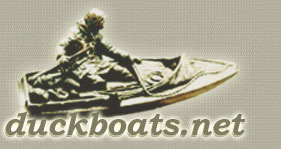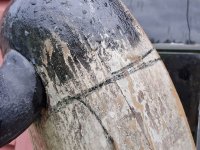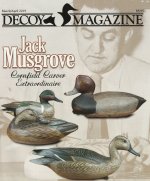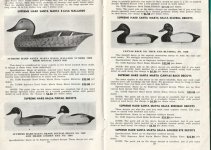Steve Sanford
Well-known member
Good morning, All~
This post probably belongs in the "Workbench" or Carvers Corner - but it's my usual mix of history and "how I do it". So, it's a bit of a hybrid - as are the stars of this tale.
I recently purchased this pair - of what Herter's would call Bluebills and I would call Broadbill. They are a "hybrid" between the earlier Model Canada and the more recent Model 72. They have balsa bodies and Tenite heads.

The Model 72 was introduced around 1955 and became the "industry standard" for 'bills gunners across the continent. Many are still in use. These are some of my rig - which I rehabbed 10 or 12 years ago. I tell the story at: https://stevenjaysanford.com/re-painting-broadbill-decoys/
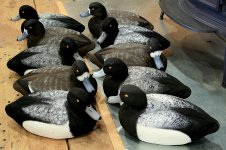
I bought this Model Canada Bluebill Drake several years ago. He had some in-use re-paint - so I "restored" him for the shelf but so he looked like he had campaigned for many seasons. BTW: I have found very few of these on-line or at shows.

When I was growing up, my Dad had 7 Bluebills and 7 Mallard/Black Mallards. He had me re-paint the former as Whistlers (Goldeneye) and the latter were stolen.

The Model Canada line was introduced in 1941. They were oversize decoys and were offered in: Mallard, Black Mallard, Bluebill, Redhead and Canvasback.

The all plastic Model 72 was introduced around 1955. Famously, the hollow plastic heads could be swiveled to any point of the compass - and so a gunner could avoid the "nervous" look of a rig will all birds staring straight ahead.
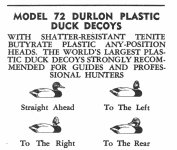
The Bluebill/Broadbill was a very good representation of the species. It's oversize dimensions made it attractive to big water gunners.
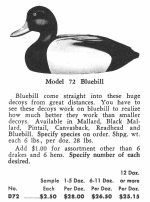 T
T
Here's one of my Model Canada Broadbill re-painted as a Whistler. I did this first when in high school (late 1960s) and again in the 1980s. I had developed a good Whistler paint scheme by then - and added Pine keels with lead poured into them. The Model Canadas need ballast for any kind of seas.
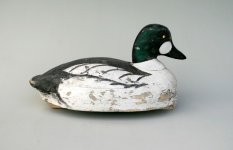
Here is the Hen:
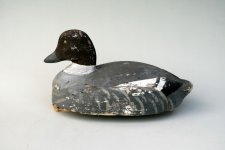
Here is one of my Dad's Model Canada "Black Mallards" - Herter's Midwestern name for Black Duck. These were used on fairly calm waters and so never needed ballast. I have a vivid memory of my Dad re-painting this rig - on our enclosed front porch with the whole family looking on.
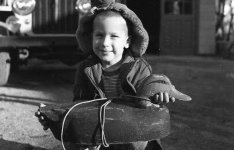
As I have reported earlier, I have been gathering Model Canada Mallards and Blacks for a "new" rig. I have about 16 now. Most are all-but-done; a few need a full restoration.
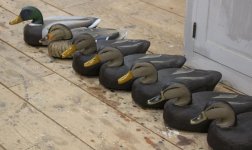
Here is one I got from Joe Daly a couple of years ago. He is in very good original paint - so will remain untouched and grace my shelves.

Here is a Drake Black Duck ready-to-hunt - except that I will likely add some ballast.

The "new" hybrids have the same Model Canada Balsa bodies but with the Tenite heads. I believe they were sold only in 1968. Whereas the brass screw eye on the original Model Canadas protruded below the body - it was mounted flush - these 1968 "hybrids" bored a shallow socket just like the early Model 72s (before they added molded keels).

After some light filling and sanding, each got sealed with Spar Varnish. (Heads are attached temporarily here.) A hot wood stove or bright sun help the varnish harden off so it can be easily scuff-sanded before the primer coat goes on.
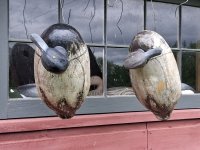
The factory paint jobs - sprayed on - were rudimentary. They had too little Black or Brown at the ends. The bodies looked OK for Canvasback but not for Broadbill. Easy enough to fix with a bit of paint....

The primer coat is flat oil paint - mostly Rustoleum. I like medium tones for decoy bottoms - either a grey or a duckboat color - so the owner's name can be marked easily.

The screw eyes and washers are solid brass. I cleaned them on the wire wheel before re-attaching the heads.

Here's the Drake all primed. One could stop here and hunt him as is, if so desired.
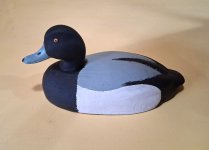
The Hen also has enough paint for gunning - but she's a bit too shiny. I was too hasty in mixing some Rustoleum Flat Brown (4 parts) with Rustoleum Flat Black (1 part). The Black was not thoroughly mixed and imparted the low sheen. In any event, both birds were first sealed with Spar Varnish (satin) then primed with flat oil paints. In my view, Hen Broadbill can be all Brown but need the White "face mask" and "wing patch". Of course, the eyes need to be Yellow and the bill Blue-grey.

This Drake has been top-coated with latex (Behr house paints). The bill and eye both got Spar Varnish. At less than 1.5 pounds, he will need a ballast keel to hunt properly on Great South Bay.
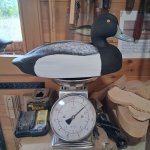
Herter's offered a couple of different ballast keels over the years - always of cast iron - what with northern Minnesota being near one of the world's largest iron deposits.... This style was offered in different weights.
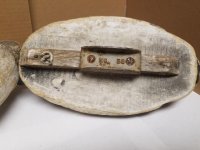
This style includes an attachment point for the anchor line.
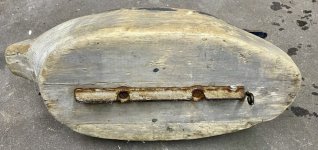
I mold this style with a screw - flattened on the grinder - that is embedded in the lead during the pour.
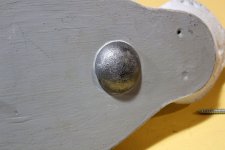
This is Al McCormick's ballast keel. It is probably what I will put on these birds.
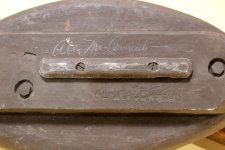
The heads were set - each at an angle - in adhesive caulk to prevent swiveling in use. I painted over the Loctite once it cured.
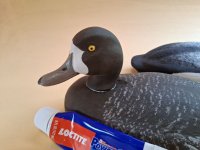
Both Hen and Drake got my usual "more than necessary but still quick" paint job.
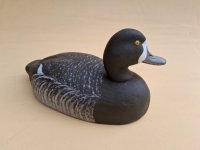
Sea trials on our frog pond....
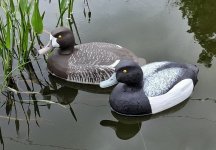
Here they are on the salt waters of Great South Bay.
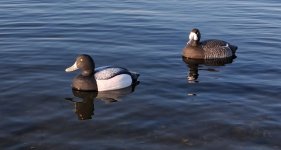
BTW: If you are painting some Broadbill, you may find this helpful: https://stevenjaysanford.com/tutorial-painting-homer-broadbill/
All the best,
SJS
This post probably belongs in the "Workbench" or Carvers Corner - but it's my usual mix of history and "how I do it". So, it's a bit of a hybrid - as are the stars of this tale.
I recently purchased this pair - of what Herter's would call Bluebills and I would call Broadbill. They are a "hybrid" between the earlier Model Canada and the more recent Model 72. They have balsa bodies and Tenite heads.

The Model 72 was introduced around 1955 and became the "industry standard" for 'bills gunners across the continent. Many are still in use. These are some of my rig - which I rehabbed 10 or 12 years ago. I tell the story at: https://stevenjaysanford.com/re-painting-broadbill-decoys/

I bought this Model Canada Bluebill Drake several years ago. He had some in-use re-paint - so I "restored" him for the shelf but so he looked like he had campaigned for many seasons. BTW: I have found very few of these on-line or at shows.

When I was growing up, my Dad had 7 Bluebills and 7 Mallard/Black Mallards. He had me re-paint the former as Whistlers (Goldeneye) and the latter were stolen.

The Model Canada line was introduced in 1941. They were oversize decoys and were offered in: Mallard, Black Mallard, Bluebill, Redhead and Canvasback.

The all plastic Model 72 was introduced around 1955. Famously, the hollow plastic heads could be swiveled to any point of the compass - and so a gunner could avoid the "nervous" look of a rig will all birds staring straight ahead.

The Bluebill/Broadbill was a very good representation of the species. It's oversize dimensions made it attractive to big water gunners.
 T
THere's one of my Model Canada Broadbill re-painted as a Whistler. I did this first when in high school (late 1960s) and again in the 1980s. I had developed a good Whistler paint scheme by then - and added Pine keels with lead poured into them. The Model Canadas need ballast for any kind of seas.

Here is the Hen:

Here is one of my Dad's Model Canada "Black Mallards" - Herter's Midwestern name for Black Duck. These were used on fairly calm waters and so never needed ballast. I have a vivid memory of my Dad re-painting this rig - on our enclosed front porch with the whole family looking on.

As I have reported earlier, I have been gathering Model Canada Mallards and Blacks for a "new" rig. I have about 16 now. Most are all-but-done; a few need a full restoration.

Here is one I got from Joe Daly a couple of years ago. He is in very good original paint - so will remain untouched and grace my shelves.

Here is a Drake Black Duck ready-to-hunt - except that I will likely add some ballast.

The "new" hybrids have the same Model Canada Balsa bodies but with the Tenite heads. I believe they were sold only in 1968. Whereas the brass screw eye on the original Model Canadas protruded below the body - it was mounted flush - these 1968 "hybrids" bored a shallow socket just like the early Model 72s (before they added molded keels).

After some light filling and sanding, each got sealed with Spar Varnish. (Heads are attached temporarily here.) A hot wood stove or bright sun help the varnish harden off so it can be easily scuff-sanded before the primer coat goes on.

The factory paint jobs - sprayed on - were rudimentary. They had too little Black or Brown at the ends. The bodies looked OK for Canvasback but not for Broadbill. Easy enough to fix with a bit of paint....

The primer coat is flat oil paint - mostly Rustoleum. I like medium tones for decoy bottoms - either a grey or a duckboat color - so the owner's name can be marked easily.

The screw eyes and washers are solid brass. I cleaned them on the wire wheel before re-attaching the heads.

Here's the Drake all primed. One could stop here and hunt him as is, if so desired.

The Hen also has enough paint for gunning - but she's a bit too shiny. I was too hasty in mixing some Rustoleum Flat Brown (4 parts) with Rustoleum Flat Black (1 part). The Black was not thoroughly mixed and imparted the low sheen. In any event, both birds were first sealed with Spar Varnish (satin) then primed with flat oil paints. In my view, Hen Broadbill can be all Brown but need the White "face mask" and "wing patch". Of course, the eyes need to be Yellow and the bill Blue-grey.

This Drake has been top-coated with latex (Behr house paints). The bill and eye both got Spar Varnish. At less than 1.5 pounds, he will need a ballast keel to hunt properly on Great South Bay.

Herter's offered a couple of different ballast keels over the years - always of cast iron - what with northern Minnesota being near one of the world's largest iron deposits.... This style was offered in different weights.

This style includes an attachment point for the anchor line.

I mold this style with a screw - flattened on the grinder - that is embedded in the lead during the pour.

This is Al McCormick's ballast keel. It is probably what I will put on these birds.

The heads were set - each at an angle - in adhesive caulk to prevent swiveling in use. I painted over the Loctite once it cured.

Both Hen and Drake got my usual "more than necessary but still quick" paint job.

Sea trials on our frog pond....

Here they are on the salt waters of Great South Bay.

BTW: If you are painting some Broadbill, you may find this helpful: https://stevenjaysanford.com/tutorial-painting-homer-broadbill/
All the best,
SJS
